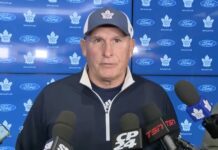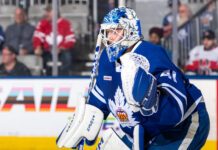On Friday morning, I took some shots at a particular writer at the PPP community that were misinterpreted. I will be taking the time to make some clarifications here.
The scoring chance tangent of my previous post had everything to do with Greg Cronin’s interview last week with Alec Brownscombe. Cronin explicitly stated that he believed that the Leafs were not out-possessed last season and made a mention that the coaching staff tracked scoring chances. I thought the premise was odd given that scoring chances are generated via shots – more shots, more scoring chances. Unfortunately, we only have one source to track scoring chances. Cam Charron will not be publishing the numbers pulled from last season, so we’re left with using Greg Sinclair’s excellent shot-tracker website.
By the way, apologies to Charron for my persistence about his scoring chance tally. I wasn’t aware he had already posted his reasons for refusing to divulge that information. I was tweeting from my phone and was on my way out the door for the weekend. So confusion aside, I don’t like it, but I understand why he’s refusing to share it. I just wanted to find out what Cronin is talking about.
According to www.somekindofninja.com site the Leafs were out-chanced at even-strength 392 to 355. I had also stated that the discrepancy of the scoring chances were not that significant for this reason from @Taylor_Wright:
@mORRganRielly When using Greg's data after 48 games I get 33.9% of Leafs SH were SC vs 30.6% of opponents. All strengths, same as before.
— Taylor John Wright (@taylor_wright) July 26, 2013
That said, I think it’s safe to say that the Leafs were soundly out-possessed at even strength – the shots taken, and not just scoring chances, by their opponents is too significant to ignore. As said before, more shots lead to more chances. However, many members from PPP and MLHS have noted that the Leafs did a fairly good job throughout the season suppressing scoring chances, but the Leafs’ first pass game exacerbated the shots against issue.
SkinnyPPPhish took a look at goals given up at four increments of distance – less than 10 feet, 10 to 20, 20 to 30, and 30+. The chart he provided showed that the Leafs were below the league average in goals given up – e.g., the Leafs were indisputably poor in suppressing scoring chances. Since the cumulative totals suggested that the Leafs were poor defensively, I had this theory that it wasn’t the system, but the goaltender: Ben Scrivens.
A while ago, Anthony Petrielli posited that the system Carlyle had in place was design to not only protect the low defensive comportment of the Leafs defense, but to funnel shots into the goaltender. As we can see, James Reimer played into that theorized system completely:
James Reimer: 34 goals, 262 shots: .870%
But Ben Scrivens didn’t:
Ben Scrivens: 25 goals, 128 shots: .805%
I think it is important to highlight that the Leafs were a totally different team with Reimer in net. For whatever reason, Scrivens lacked the ability to stop scoring chances at or above the league average.
Last season, the Leafs gave up an estimated total of 392 scoring chances. Of those chances given up, they gave up 59 goals for a save percentage of .849. I took the liberty of charting the other 29 team’s even strength scoring chances and goals given up.

A few notes from the chart above:
a) Edmonton had the league’s best save percentage, but also the worst at suppressing scoring chances;
b) Chicago was surprisingly one of the worst teams in giving up scoring chances, but somehow managed to keep the puck out of the net;
c) New Jersey was the league’s best at suppressing scoring chances (worth noting that Mark Fraser compared the Leafs defensive system to the Devils;
So to summarize the chart, the Leafs were 8th overall in suppressing scoring chances, at league average in both goals against and save percentage. These numbers do NOT line up with SkinnyPPPhish’s conclusions. While total shots against were definitely an issue, scoring chances were not. If the Leafs wanted to suppress scoring chances, they did an excellent job of it last season.
I thought about the numbers in front of me and theorized that many of the teams who managed to suppress scoring chances and / or prevent resulting goals had a very strong defense – Los Angeles, Chicago, etc. Or had incredible goaltending – New York Rangers, Columbus, etc. Or both. For me, the Leafs result goes back to what Petrielli said about the Leafs’ defensive system: the defense was atrocious and the goaltenders needed to play into the shot funneling. While Reimer played his role, Scrivens did not. This might partially explain why the Leafs traded for upside in Jonathan Bernier.
I’m still not convinced that Cronin was giving us the entire story. We know that the Leafs have their own in-house shot trackers – this is indisputable as every team has some arrangement of video and stat tracking. Carlyle has made a few mentions about the shots against being an issue, but if I am remembering correctly, he inferred that the issue had to do with execution – it may also suggest a personnel issue. Unfortunately, thanks to the many topics on this subject, Google turned up too many results. So until someone finds the article, you’ll have to take my word for it.
Some of the issues are as followed:
1) The lack of a consistent breakout game absolutely robbed the Leafs of momentum in many games this season. In some sequences, in particular against Boston during the first round, the Leafs were hemmed in their own end unable to move the puck out of their zone;
2) The rotation of the centre in lieu of a defenseman moving to cover the net did not always result in good board coverage. This might be one of the execution issues that Carlyle referred to;
3) Because the Leafs used a variant of a box plus one system, they were usually down one extra break out option;
4) The wingers often broke out of the zone and ahead of the play to beat the defensemen for a scoring chance.
All these issues compounded the shot suppression problem. My hope is that with a full training camp and a positive outcome with Franson’s contract negotiation, with improvements from the defense with Gardiner taking a full time role in the Leafs top-four, the organization can move forward in suppressing shots, while maintaining their proficiency in eliminating scoring chances against.
I hope my explanation clears up Friday morning’s many questions.




































